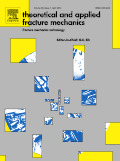
THEORETICAL AND APPLIED FRACTURE MECHANICS
Scope & Guideline
Driving excellence in theoretical and applied research.
Introduction
Aims and Scopes
- Fracture Mechanics Theory:
The journal emphasizes theoretical developments in fracture mechanics, including mathematical modeling, stress analysis, and the derivation of new analytical solutions for various crack problems. - Material Behavior and Failure Mechanisms:
Research articles often investigate the mechanical behavior of materials under various loading conditions, including static, dynamic, and cyclic loads, focusing on how these conditions influence the initiation and propagation of cracks. - Experimental Techniques and Validation:
The journal publishes studies that utilize experimental methods, such as digital image correlation and acoustic emission, to validate theoretical models and provide insights into the fracture processes of different materials. - Computational Methods:
There is a strong focus on computational approaches, including finite element methods (FEM), peridynamics, and phase-field models, which are employed to simulate and analyze fracture behavior in complex materials and structures. - Application in Diverse Materials:
The journal covers a wide array of materials, including metals, polymers, concrete, and composites, highlighting the unique fracture characteristics and challenges associated with each material type. - Interdisciplinary Research:
The journal encourages interdisciplinary studies that integrate concepts from materials science, mechanical engineering, geotechnical engineering, and applied physics to address fracture mechanics challenges.
Trending and Emerging
- Machine Learning Applications in Fracture Mechanics:
There is an increasing trend towards utilizing machine learning techniques to predict fracture behavior, analyze crack growth, and optimize material properties, highlighting the intersection of artificial intelligence and engineering. - Hydrogen Embrittlement Studies:
Research focused on the effects of hydrogen on material properties and fracture behavior is gaining prominence due to the growing relevance of hydrogen technologies in various industries, including energy and transportation. - Multiscale and Multiphysics Modeling:
The integration of multiscale approaches that combine microscopic and macroscopic analyses is becoming more common, as researchers seek to understand fracture mechanisms across different levels of material structure. - Sustainability in Material Design:
There is a noticeable increase in studies examining the fracture behavior of sustainable materials, such as recycled composites and bio-based materials, in response to global sustainability challenges. - Dynamic Fracture Mechanics:
Research investigating dynamic fracture processes, including impact loading and high strain rates, is on the rise, reflecting the need for understanding material behavior under extreme conditions. - Advanced Experimental Techniques:
The use of innovative experimental methods, such as digital image correlation and acoustic emission monitoring, is trending, providing deeper insights into the fracture processes and real-time monitoring of material failure.
Declining or Waning
- Traditional Crack Models:
There has been a noticeable decline in publications focusing solely on classical models of crack propagation, such as linear elastic fracture mechanics (LEFM), as researchers increasingly explore more complex and realistic models that account for material heterogeneity and non-linear behavior. - Static Analysis of Fracture Problems:
There seems to be a decreasing emphasis on purely static analyses of fracture problems, with more studies moving towards dynamic and time-dependent fracture behaviors, reflecting a broader interest in real-world applications and conditions. - Single Material Studies:
Research focusing exclusively on single materials without considering their interactions with other materials or environmental factors appears to be declining, as interdisciplinary approaches gain traction. - Simplistic Experimental Techniques:
The use of basic experimental methods without advanced imaging or monitoring techniques, such as digital image correlation or acoustic emission, is diminishing, signaling a shift towards more sophisticated methodologies.
Similar Journals
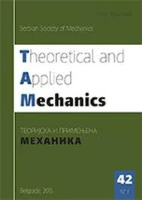
Theoretical and Applied Mechanics
Unlocking the Potential of Computational Mechanics.Theoretical and Applied Mechanics is a premier open-access journal published by the Serbian Society of Mechanics, dedicated to advancing the fields of Applied Mathematics, Computational Mechanics, and Mechanical Engineering. Since its inception, this journal has provided a vital platform for researchers and practitioners to publish high-quality, peer-reviewed articles that contribute to our understanding of theoretical concepts and their practical implications in mechanics. With an ISSN of 1450-5584 and a growing international readership, Theoretical and Applied Mechanics aims to bridge the gap between theory and application, making significant strides in the engineering community. Although the journal is currently ranked in the Q4 category across its scopes, it encourages innovative research that fosters interdisciplinary collaboration. For those interested in exploring cutting-edge developments in the mechanics field, this journal offers an invaluable resource for researchers, professionals, and students alike.

INTERNATIONAL JOURNAL OF IMPACT ENGINEERING
Pioneering advancements in applied sciences.Welcome to the International Journal of Impact Engineering, a premier publication dedicated to advancing the field of engineering and applied sciences, with a particular focus on impact phenomena across various sectors including aerospace, automotive, civil and structural engineering, mechanical engineering, and more. Published by Pergamon-Elsevier Science Ltd in the United Kingdom, this journal has garnered a prestigious Q1 category ranking in multiple engineering disciplines as of 2023, underscoring its significant contribution to both academic and industrial research. With an ISSN of 0734-743X and E-ISSN 1879-3509, the journal promotes rigorous peer-reviewed articles that address both theoretical and experimental aspects of impact engineering. Spanning from 1983 to 2025, it serves as a vital resource for researchers, professionals, and students aiming to explore innovative solutions and cutting-edge developments in their respective fields. The International Journal of Impact Engineering remains committed to disseminating high-quality research that drives progress towards safer and more efficient engineering practices.

INTERNATIONAL JOURNAL OF FRACTURE
Connecting Researchers through Cutting-edge Fracture InsightsInternational Journal of Fracture, published by Springer, stands as a leading peer-reviewed platform dedicated to advancing the field of fracture mechanics and its applications. Since its inception in 1973, this journal has provided a crucial forum for innovative research and discussions, addressing pivotal topics in computational mechanics, mechanics of materials, and modeling and simulation. With a significant impact factor and a Q1 classification in computational mechanics, it ranks impressively within the Scopus metrics, further solidifying its relevance among global researchers and professionals. The journal caters to an international audience by fostering the exchange of knowledge and cutting-edge discoveries, making it an essential resource for those engaged in the latest advancements and applications in material fracture studies. Its commitment to high-quality research ensures that the findings published within its pages not only contribute to academic discourse but also influence real-world engineering and manufacturing practices.

Journal of Theoretical and Applied Mechanics
Exploring the Intersection of Theory and PracticeJournal of Theoretical and Applied Mechanics, published by the Polish Society of Theoretical and Applied Mechanics, stands as a leading platform for disseminating cutting-edge research in the realms of theoretical and applied mechanics. With its ISSN 1429-2955 and E-ISSN 1429-2955, this Open Access journal has been fostering academic dialogue since 2006, making knowledge readily accessible to researchers and practitioners alike. Based in Warsaw, Poland, the journal encompasses a wide breadth of topics within mechanics, appealing to a diverse readership including researchers, professionals, and students. The journal's current Scopus ranking places it within the 30th percentile of the field, emphasizing its relevance and contribution to the discipline. As it converges from 2007 to 2024, the Journal of Theoretical and Applied Mechanics is pivotal for those seeking to advance understanding and innovation in mechanical engineering and mathematics, making it an essential resource for anyone involved in these critical areas of study.
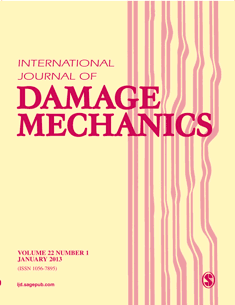
INTERNATIONAL JOURNAL OF DAMAGE MECHANICS
Unveiling Insights into Damage MechanismsINTERNATIONAL JOURNAL OF DAMAGE MECHANICS, published by SAGE PUBLICATIONS LTD, stands as a pivotal peer-reviewed platform contributing to the fields of damage mechanics, computational mechanics, and materials science. With its ISSN 1056-7895 and E-ISSN 1530-7921, this esteemed journal has charted an impressive trajectory since its inception in 1992 and continues to influence the academic community through its high-quality research outputs. Recognized for its excellence, the journal has consistently ranked in the Q1 quartile across various categories including Computational Mechanics and Mechanical Engineering in 2023, reflecting its critical impact in these domains. It has attained an outstanding Scopus rank of #7/89 in Computational Mechanics, positioning it within the top tier of journals in the engineering discipline. The journal's commitment to advancing knowledge is further underscored by its broad scope that attracts innovative research, making it an essential resource for researchers, professionals, and students alike. Though it operates under a traditional subscription model, readers are encouraged to access its wealth of information, which is instrumental in promoting scholarly communication and driving forward the frontiers of damage mechanics.
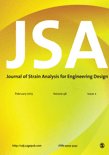
JOURNAL OF STRAIN ANALYSIS FOR ENGINEERING DESIGN
Pioneering Research in Mechanics and Materials Engineering.The Journal of Strain Analysis for Engineering Design, published by SAGE Publications Ltd, is a prestigious academic journal that has been at the forefront of *engineering and applied mathematics* research since its inception in 1965. With a focus on the intricate analysis of strain in engineering design, this journal serves as a vital resource for researchers and professionals seeking to push the boundaries of understanding in mechanics and materials engineering. As of 2023, it enjoys a respectable ranking in its respective fields, including Q2 in *Mechanical Engineering* and *Mechanics of Materials*, and Q3 in *Applied Mathematics* and *Modeling and Simulation*, reflecting its significant contribution to the academic community and relevance in practical applications. Although it is not an open-access journal, its rigorous peer-review process ensures the dissemination of high-quality research. The journal provides a platform for innovative ideas and methodologies, fostering advancements in engineering design and analysis vital for both academia and industry. By bridging theoretical foundations with real-world applications, the Journal of Strain Analysis for Engineering Design remains an essential publication for those dedicated to addressing the complexities of modern engineering challenges.
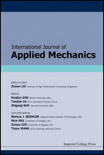
International Journal of Applied Mechanics
Empowering Innovation in Mechanical EngineeringThe International Journal of Applied Mechanics, published by World Scientific Publishing Co Pte Ltd, is a premier platform that serves the fields of materials science, mechanical engineering, and mechanics of materials. Located in Singapore, this journal has established itself as a crucial resource for researchers, professionals, and students, with its convergence of scholarly work from 2009 to 2024. Ranked in the Q2 category across notable disciplines, including Materials Science, Mechanical Engineering, and Mechanics of Materials, it reflects a strong commitment to publishing high-quality research that pushes the boundaries of knowledge in applied mechanics. Despite being a non-open access journal, its successful Scopus rankings, including an impressive rank of #151 in Mechanical Engineering, signify its substantial impact and recognition within the academic community. This journal not only aims to disseminate pioneering research but also to foster collaboration and innovation in the rapidly evolving landscape of applied mechanics.

Frattura ed Integrita Strutturale-Fracture and Structural Integrity
Connecting Scholars to Shape the Future of EngineeringFrattura ed Integrita Strutturale - Fracture and Structural Integrity is a prominent open-access journal published by GRUPPO ITALIANO FRATTURA since 2007, dedicated to advancing the fields of Civil and Structural Engineering, Mechanical Engineering, and Mechanics of Materials. With an E-ISSN of 1971-8993, this journal has established itself as a significant platform for researchers and practitioners in the engineering community, offering an accessible outlet for high-quality research and innovative methodologies. The journal has achieved impressive standings in the Scopus ranks, notably being positioned in the second quartile (Q2) across its relevant categories in 2023, indicating its growing influence and the quality of the research it disseminates. With a publishing scope extending from 2011 to 2024, Frattura ed Integrita Strutturale continues to be an invaluable resource for addressing the mechanics of material integrity and fracture phenomena, inviting contributions that advance understanding and foster multidisciplinary dialogue. By prioritizing open access, the journal ensures that vital research is readily available to a global audience, enhancing collaboration and knowledge sharing among academia and industry alike.

EXPERIMENTAL MECHANICS
Fostering Collaboration for Engineering Excellence.EXPERIMENTAL MECHANICS, published by SPRINGER, stands at the forefront of research in the fields of Aerospace Engineering, Mechanical Engineering, and Mechanics of Materials. Established in 1961, this esteemed journal has made significant contributions to the understanding and advancement of experimental methodologies and techniques essential for both academic research and practical applications in engineering. With an impressive impact factor and recognition as a Q2 journal in its category for 2023, it ranks 40th in Aerospace Engineering and has established itself as a valuable resource for researchers and practitioners alike. Although it is not an Open Access journal, it provides robust access options, ensuring that high-quality research remains accessible to a broad audience. The journal aims to disseminate innovative findings, foster collaboration, and inspire the next generation of engineers and scientists by focusing on the challenges and developments within experimental mechanics. The editorial board comprises leading experts in their respective fields, further emphasizing the journal’s commitment to excellence and relevance in an ever-evolving technological landscape.
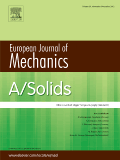
EUROPEAN JOURNAL OF MECHANICS A-SOLIDS
Exploring Innovations in Material ScienceThe EUROPEAN JOURNAL OF MECHANICS A-SOLIDS, published by ELSEVIER and based in the Netherlands, stands as a premier outlet for research in the field of solid mechanics. With an impressive track record since its inception, the journal has been indexed in prestigious categories including Materials Science, Mechanical Engineering, and Mathematical Physics, achieving Q1 quartile status across these domains in 2023. This recognition underscores the journal's impact, with Scopus rankings placing it in the top echelon of its respective fields, such as #39 in General Physics and Astronomy and #116 in Mechanical Engineering, demonstrating its significance and wide-reaching influence in the academic community. Scientists, engineers, and researchers are encouraged to submit their cutting-edge findings in areas related to solid mechanics, contributing to the journal's mission of advancing knowledge and innovation in this vital discipline. The journal's comprehensive scope allows for interdisciplinary engagement, making it an essential resource for professionals and students alike seeking to explore the latest developments in mechanics of materials and related areas.